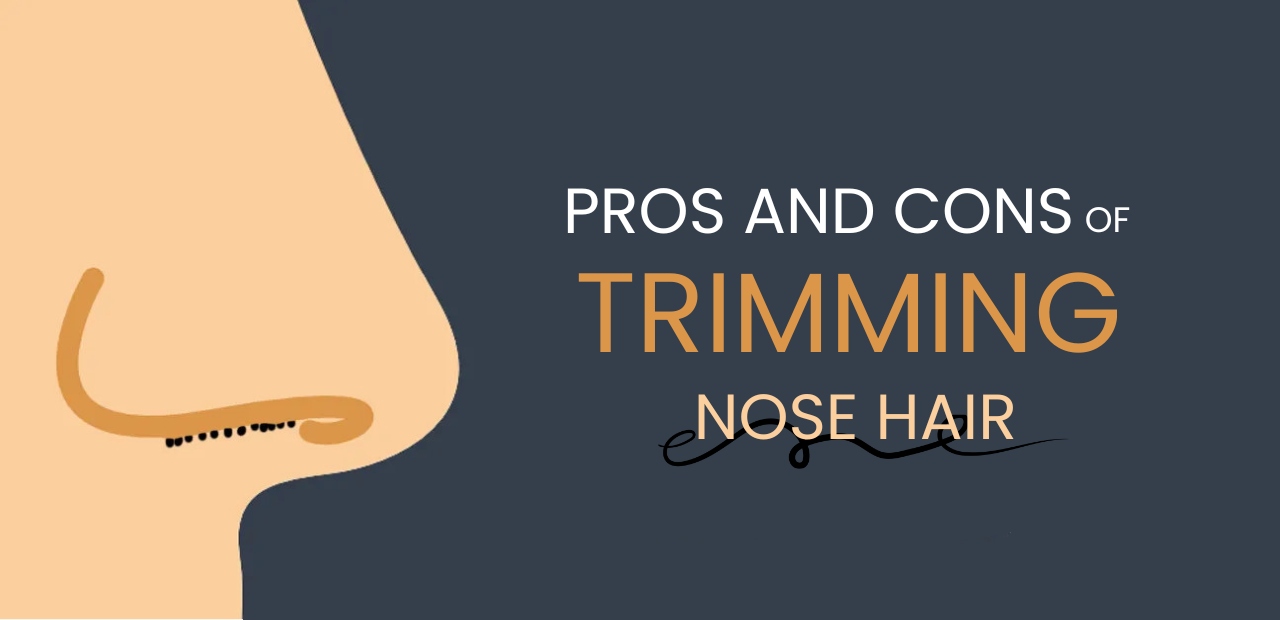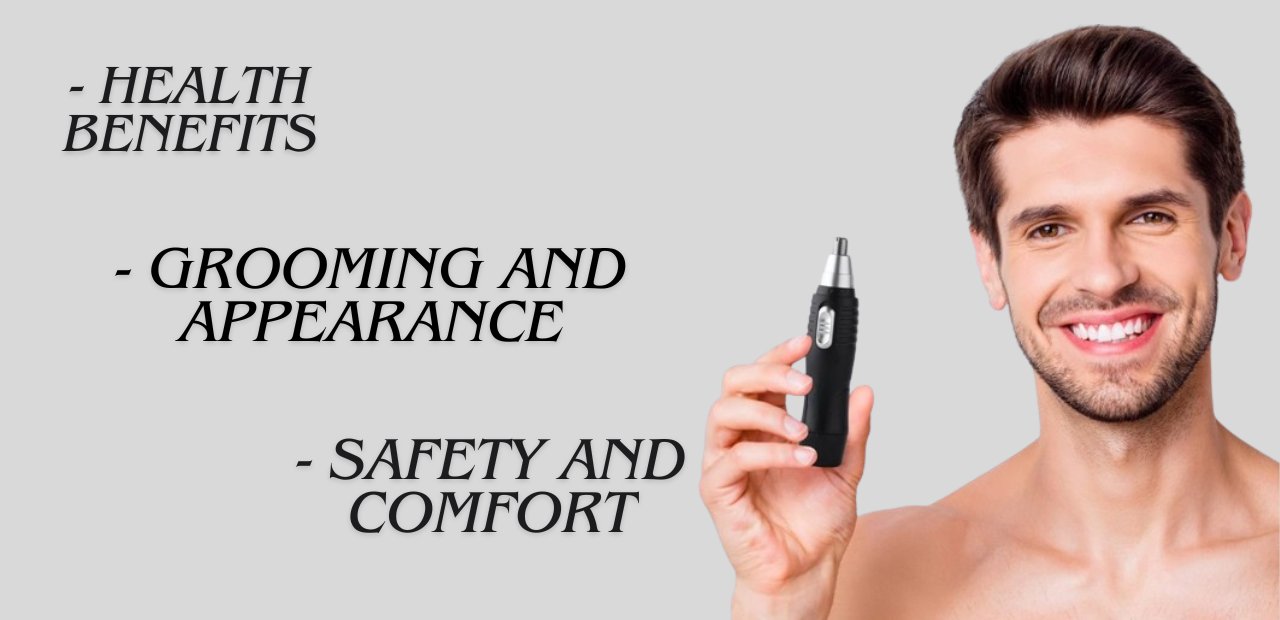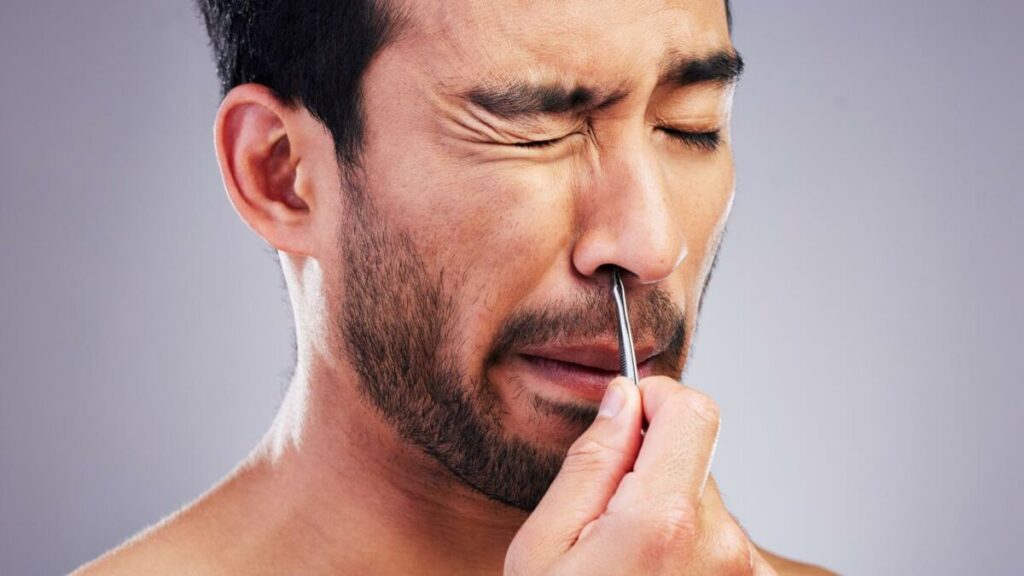
Nose hair protects our nasal passages from dust, allergens, and other particles that could cause irritation or infection. However, when nose hair becomes excessively long, it can protrude from the nostrils and become unsightly. Many ponder the benefits of trimming their nose hair for a more polished appearance. Join us as we delve into the various viewpoints on this divisive topic and weigh the advantages and disadvantages of taming those pesky nasal strands.
Table of Contents
Trimming Nose Hair Pros And Cons are something that we need to know.
Regarding the cutting of nose hair, there are advantages and disadvantages to consider. Trimming nose hair may seem like a quick fix for achieving a polished look, but there are important considerations. From potential health risks to cultural perceptions, the decision to trim or not trim your nasal foliage is not as straightforward as it seems. We will get into a comprehensive examination of the debate surrounding nasal hair grooming, offering a well-rounded view of the benefits and drawbacks of trimming nasal hair.
By providing you with complete details, Our goal is to provide you with the knowledge and resources necessary to make a well-informed choice about this frequently neglected part of personal care. So buckle up and get ready to explore the fascinating world of nasal maintenance!
Pros of trimming nose hair

Now, we’ll delve into the often overlooked advantages of attending to this seemingly small grooming task and explore why trimming nose hair could be a game-changer for your overall well-being and presentation. So, if you’re ready to uncover the surprising perks of taming those pesky nasal hairs, read on for a fresh perspective that might just leave you reaching for those trusty grooming scissors.
1. Health Benefits –
- Prevents infections: Nasal hair trimming could play a significant role in preventing infections. Those little bristles lining your nostrils are not just for aesthetics; they are active defenders against potential health crises. A proactive protocol of maintaining healthy nose hairs can contribute immensely towards reducing the risk of respiratory and other infections. While nose hair acts as nature’s filtration system to limit entryway for harmful particles and germs to reach the lungs, overgrown strands may trap these culprits for too long, leading to possible bacterial growth or fungal breeding grounds right at your sinus doorstep. Hence, regular trimming is not a cosmetic luxury but an imperative hygiene routine. It aids in ‘cleaning up’ this vital filter system on time rather than allowing it to become an overloaded harboring zone for infections.
- Improves breathing: Trimming nose hair may not only be about maintaining a neat appearance but can also significantly improve your breathing. Excessively long nose hair can obstruct the airway and airflow into the nasal passages, leading to difficulty breathing. By keeping nose hair trimmed, you can create a clear path for air to pass through, allowing for better airflow and improved breathing. In addition to enhancing airflow, trimming nose hair can reduce the likelihood of inhaling dust, allergens, and other airborne particles that may get caught in longer hair strands. It can minimize the risk of respiratory irritation and allergic reactions, ultimately contributing to better overall respiratory health. As a result, keeping your nose hair trimmed regularly has both aesthetic benefits and is essential for improving your ability to breathe and maintaining the health of your respiratory system.
- Reduces allergies: Trimming the nose hairs reduces allergens’ access to your body’s mucous membranes, where they stimulate allergic reactions such as runny noses and watery eyes. Nose hairs often trap allergens like pollen grains or mold spores, leading to irritation; trimming them minimizes this encounter while offering enough protection against harmful microbes and larger particulates. So, the next time you’re considering a quick trim or tweeze, remember that you will stay aesthetically sharp and maintain clear airways, resulting in fewer allergies.
2. Grooming and Appearance –
- Enhances facial aesthetics: Trimming nose hair is about cleanliness and personal hygiene and dramatically contributes to facial aesthetics. Nasal hair plays a vital role in trapping dirt particles, allergens, and microbes. However, excessive or sprouting nose hairs can distort your facial balance and the symmetry of your features, which can be quite distracting from an aesthetic standpoint. A well-groomed look resonates with confidence and charisma. By delicately trimming these stray follicles using the correct tools (such as a nose hair trimmer or grooming scissors), you ensure that people’s attention focuses on more striking features of your face, like sparkling eyes or a radiant smile instead of a protruding nasal mane. Thus, regular maintenance and proper grooming techniques for nasal hair can significantly enhance overall facial appearance, giving it a clean and sharp look.
- Boosts self-confidence: Maintaining a well-groomed appearance goes beyond just looking good. Trimmed nose hair gives you the edge of self-assurance during face-to-face interactions. It could make all the difference when first impressions matter—professional interviews, romantic dates, or public speaking engagements. Surprisingly simple yet strikingly impactful, this personal grooming practice significantly enhances your self-image.
3. Safety and Comfort –
- Prevents irritation: Nose hair is a small but essential part of our body that traps foreign particles, such as dust, microbes, and pollen, which irritate the nasal passages. The more debris caught in your nose hair, the more irritated and swollen the surrounding skin may become. Trimming provides an efficient path for particles to exit smoothly without causing distress. It’s a delicate balance: removing excess hair eases potential irritation while leaving enough to perform its protective duties. So next time you experience constant scratching or tickling sensations within your nostrils, why not try a careful trim? Not only will it bring relief, but it will also keep those blocked noses at bay!
- Avoids accidental pulling: Imagine the discomfort or unbearable pain from accidentally pulling on your nostril hair. Makes you wince. Trimming nose hair is one efficient way to dodge this inconvenience. Regularly grooming these tiny antennas can shield you from unfortunate incidents of tugging or, even worse, aggressive sneezes! Not to mention, it provides an aesthetic appeal and boosts hygiene levels up a notch. Breathe easy, knowing that a simple trim can keep your nasal passages clean, clear, and undisturbed by intrusive hairs. Everybody should learn how to use electric nose hair trimmer for more safely cut those hairs.
Conclusion – Trimming nose hair is not just about appearance; it also has numerous health benefits. It can minimize the likelihood of infections, enhance respiratory function, and promote general cleanliness. So, take into account the importance of nose hair grooming. It’s a small step that can make a big difference in your well-being. So, invest in a good nose hair trimmer and make it a part of your regular grooming routine.
Cons of trimming nose hair

Nose hair, the unsung hero of our respiratory system, often goes unnoticed until it becomes too unruly to ignore. Trimming nose hair has become common for many individuals seeking a neat appearance. However, despite its apparent benefits, some compelling reasons exist to reconsider reaching for those trimmers. While maintaining a well-groomed image is essential, the cons of trimming nose hair may surprise you and make you think twice before embarking on this seemingly harmless grooming routine.
1. Health Aspect –
- Risk of Ingrown Hairs: Trimming nose hair may seem like a harmless grooming task, but the risk of developing ingrown hairs can increase by trimming nose hair. When we trim our nose hair, we create sharp edges on the remaining hair, which can easily pierce the skin and cause irritation. Irritation can trigger inflammation, which may eventually cause ingrown hairs. Moreover, when nose hair is trimmed too close to the skin, it may not have enough support to grow outward correctly. Instead, the regrowth might curl back into the skin, causing ingrown hairs. Additionally, frequent trimming of nose hair can disrupt the natural protective function of these hairs, leaving the nasal passages more vulnerable to infection and irritation.
- Disruption of Natural Filtering Function: When it comes to self-grooming, trimming nose hair is often seen as necessary. However, few realize that this seemingly harmless act can disrupt the natural filtering function of the nose. The hairs in your nose are vital in protecting your respiratory system from harmful substances. They help block the entry of foreign particles, bacteria, and allergens, keeping them from causing harm to your body. Individuals risk compromising this vital defense mechanism by trimming these hairs excessively or incorrectly. Disrupting the natural filtering function can increase respiratory infections and allergy vulnerability. Insufficient nasal hairs increase the risk of inhaling harmful particles and substances into the lungs, leading to various health problems. Furthermore, with the loss of this protective barrier, individuals may also experience increased discomfort and irritation in response to environmental pollutants and allergens.
- Possibility of Nerve Damage: Nose hair trimming is standard grooming, but few people know the potential risk of associated nerve damage. The nose is a susceptible area, and any mishap during trimming could lead to nerve injury. The proximity of nerves to the skin’s surface in the nasal cavity makes them vulnerable to damage from sharp instruments or excessive force. One possible cause of nerve damage during nose hair trimming is applying too much pressure or using an inappropriate tool. For instance, scissors with pointed tips instead of rounded ones can increase the likelihood of accidental cuts and subsequent nerve injury. Trimming the nose too aggressively or quickly can improve the chances of harming the sensitive nerves in the nasal area. Although uncommon, such injuries can lead to feelings of pain, loss of sensation, or changes in how the affected area feels.
2. Aesthetic Concerns –
- Increased Visibility of Nostrils: When it comes to grooming, the issue of trimming nose hair sometimes goes overlooked. However, a surprising side effect of this routine maintenance can be an increased visibility of nostrils. While nose hair is crucial in filtering harmful particles, excessive growth can lead to an unsightly appearance. When these hairs are regularly trimmed or removed, the result may be a more exposed nasal passage. The heightened visibility of nostrils after trimming nose hair may come as a surprise to some individuals. This change can draw attention to the inner workings of the respiratory system and highlight the intricate structure within our noses. From a grooming standpoint, this shift in visibility may prompt individuals to consider new techniques for maintaining their nasal region or exploring natural remedies that promote healthier growth without sacrificing aesthetics.
- Difficulty in Achieving a Natural Look: After trimming nose hair, many may find it challenging to achieve a natural look, often leading to frustration and discomfort. The key is to strike the right balance between keeping the nasal passages clear without over-trimming, as excessive removal can result in an unnatural or slightly plucked appearance. This delicate task requires patience and precision, as abrupt trimming can cause irritation or ingrown hairs that detract from a natural aesthetic. Moreover, specialized, safe, precise nasal hair-trimming tools can significantly improve results. These tools offer finer control over the level of grooming necessary while reducing the likelihood of accidental nicks or cuts.
Conclusion – While trimming nose hair may seem like a harmless grooming practice, there are several cons to consider. Firstly, over-trimming can lead to irritation and discomfort in the nasal passages. The delicate skin inside the nostrils can quickly become irritated from frequent trimming, leading to redness and even minor cuts that can be painful and prone to infection. Additionally, excessive nose hair removal can increase the risk of ingrown hairs in the nasal area, causing further discomfort and potential health issues.
Furthermore, removing too much nose hair can disrupt its natural function of filtering out dust, allergens, and other particles from entering the respiratory system, leading to increased susceptibility to allergies and respiratory infections. While maintaining well-groomed nose hair is vital for personal hygiene and appearance, it’s crucial to be mindful of not overdoing it, as it could result in more harm than good.
FAQs
1. Is trimming nose hair safe?
Yes, as long as you use proper tools and techniques.
2. Can trimming nose hair cause infections?
It can if not done correctly, so it’s important to be cautious.
3. How often should I trim my nose hair?
It depends on individual growth, but generally, every 1-2 weeks is sufficient.
4. Are there any risks associated with trimming nose hair?
If done improperly, there’s a risk of cuts or irritation in the nostrils.
5. Should I use scissors or trimmers for nose hair grooming?
Trimmers specifically designed for the nose are recommended for safety and precision.
6. What tools are best for trimming nose hair?
For safe and effective grooming, nose hair trimmers with rounded tips or small scissors specifically designed for this purpose are recommended.
7. Should I remove entirely all my nose hair?
No, it’s important to leave some natural protection in place. Trimming rather than complete removal is usually recommended.



